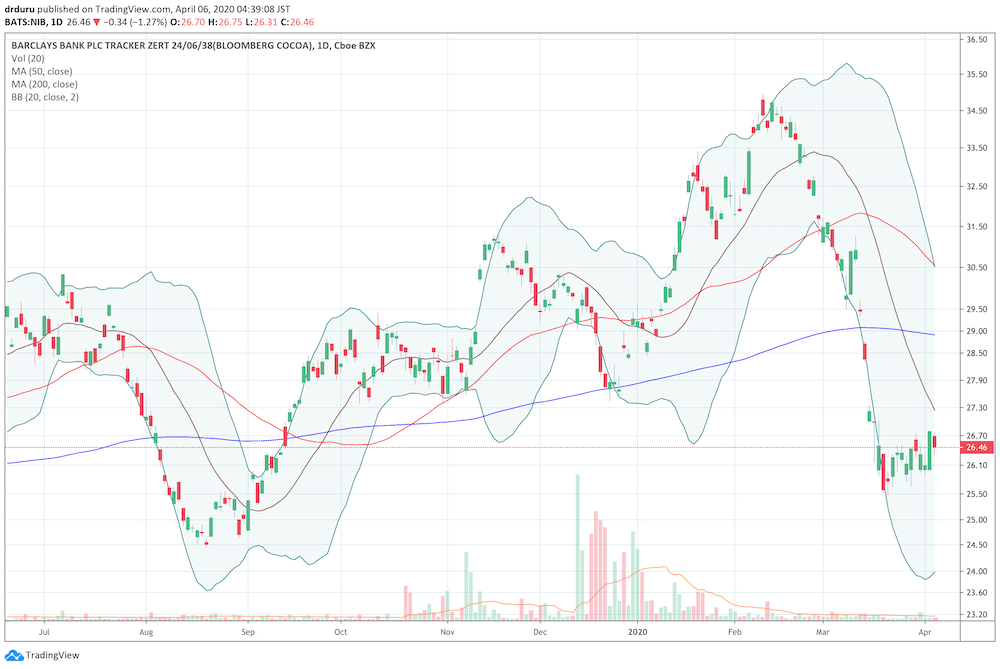Cocoa prices have plunged along with the pandemic-driven crash in global financial markets. The iPath Bloomberg Cocoa Subindex Total Return ETN (NIB) reached a closing peak on February 13th just ahead of the global pandemic crisis. Since then, NIB is down 23.8%, a bear market in cocoa.

Per my buy-the-dip strategy in NIB, this is a time to start re-accumulating shares in NIB. I always buy the sell-offs. Since the sell-offs remain inevitable, I also sell the rallies. As a reminder, I am a long-term, perma-bull in cocoa given strong underlying secular demand for cocoa and the creeping limitations on cocoa supplies. I never short cocoa and want to act in a farmer-positive way. However, conditions invariably converge to apply selling pressure in the cocoa trading market. A recent article in Invezz summarizes much of my bullish thesis: “Is investing in cocoa a tasty move right now?“
A weekly chart in NIB makes the technical buying (and selling) opportunity even clearer. For over two years, NIB has drifted ever slowly upward. A slight upward bias in this move means that I do not get cute with trying to time an exact bottom (last December was a classic example).

Source for charts: TradingView.com
The last monthly market review from the International Cocoa Organization (ICCO) was published for February, 2020. The report ascribed the early February strength in prices to “…the less conducive meteorological conditions that prevailed in West Africa’s cocoa growing regions.” The ICCO blamed the subsequent weakness on good weather conditions (supply positive) and concerns about demand due to the growing threat from coronavirus. (Ghana recently launched a program in partnership with ECOM Ghana to distribute soap to its farmers as a preventive measure against the coronavirus). Once the world is on the other side of this pandemic, cocoa demand should recover along with global economies. So, this is not the time to bet on permanent damage to the love of chocolate. Indeed, in an interview with Yahoo Finance Nestle’s CEO earlier suggested that a surge in demand for baking products included chocolate as people do more cooking at home. People’s taste for chocolate has not changed.
The ICCO projected another record season (2019-2020) for production from the Ivory Coast of 1.567M tonnes, marginally higher than the 1.564M tonnes a year ago. Ghana should produce 850,000, far short of the country’s ambitious 950,000 forecast last year. The Ghana Cocoa Board (COCOBOD) continues to make aggressive forecasts with a 1M target for the 2020-21 growing season. Ghana continues to struggle with Cocoa Swollen Shoot Virus Disease (CSSVD) which has infected 17% of its cocoa farms.
The ICCO reported strong demand for November, 2019 but the numbers for February were quite mixed with North America provided the drag.
“Grindings are expected to expand to 4.861 million tonnes, up by 56,000 tonnes. This higher forecast reflects the continuous increase in demand which is mirrored by the steady growth in cocoa processing in origin countries as well as an increase in the demand for chocolate with high cocoa content. It is projected that processing activities will grow by 6.9% to 1.237 million tonnes in Asia and Oceania whereas a growth of 1.9% to
1.054 million tonnes is anticipated in Africa. On the contrary, in the Americas, processing activities are forecast to shrink by 3.4% to 870,000 tonnes while a 1.5% drop to 1.700 million tonnes is envisaged in grindings activities for Europe as compared to the level attained in the same period of the previous season.”
Finally, the latest cocoa-related weather report from Reuters points to favorable growing conditions. The anticipation of more supply-positive news is likely contributing to the weight on prices. I am looking to add to my position if NIB hits $25 and every two or three dollars below that in the worst case scenario.
Be careful out there!
Full disclosure: long NIB
